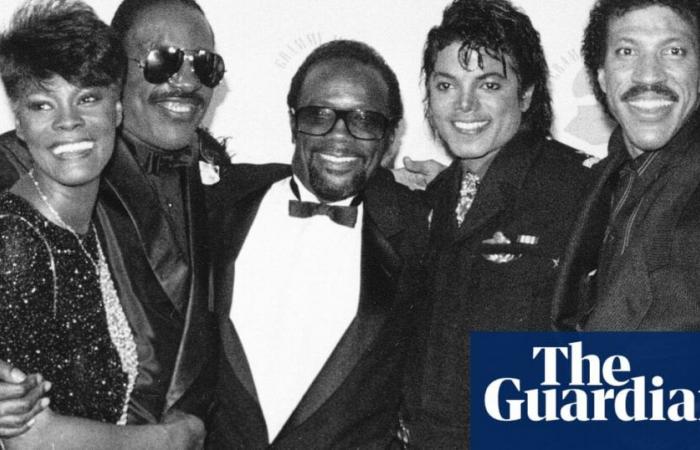
Over the course of 91 years, Quincy Jones did pretty much everything you could do in the entertainment industry. He was a musician, arranger, composer, solo artist, record company executive, mogul, entrepreneur and a producer not just of music but of films and TV – and, as was noted in Chris Heath’s extraordinary, headline-grabbing 2018 profile piece Quincy Jones Has a Story About That, he had known everyone. “The ghetto Gump”, as he called himself, referring to Forrest, was the thread that linked Dizzy Gillespie and Miles Davis to Dr Dre and the Weeknd; a musician who’d appeared with Elvis Presley and Amy Winehouse, Count Basie and Bono, Nat King Cole and Young Thug; the man who had a credit on Sinatra At the Sands and Harry’s House by Harry Styles.
It’s a résumé unlike any other. How did he achieve it? He was clearly driven, perhaps as the result of a difficult childhood. Born on the gang-ridden South Side of Chicago during the Great Depression, Jones wandered into “the wrong neighbourhood” aged seven, was stabbed through the hand with a switchblade and attacked with an icepick. His mother suffered a nervous breakdown and was committed to a psychiatric hospital. Jones spent time living with his grandmother in Kentucky in such poverty that he claimed they survived by eating rats. Then his father moved the family to Washington and remarried, to a woman Jones said was physically abusive.
Jones was also prodigiously talented, still at college when he was invited to quit in order to work with vibraphonist and former Benny Goodman sideman Lionel Hampton. Hampton had started his own orchestra, a big band nimble enough to traverse the end of the swing era and take the rise of bebop and of rhythm and blues in its stride: an object lesson in staying open-minded and moving with the times that one suspects stayed with Jones.
Certainly, when he moved to New York and began working as a freelance arranger, Jones’s approach was admirably catholic: his list of clients ranged from big-band luminaries including Count Basie and Gene Krupa, to stars from jazz’s new wave – Clifford Brown and Cannonball Adderley among them – to rhythm and blues artist Big Maybelle, whose original version of Whole Lotta Shakin’ Goin’ On Jones arranged and produced.
His ability to slip between genres may well have involved a degree of pragmatism. He had become a recording artist in his own right in the late 50s, leading bands staffed with impressive musicians – one session for his second album featured Charles Mingus, Milt Jackson, Art Farmer and Herbie Mann – but when he formed his own 18-piece big band in Europe in 1959, they achieved both critical acclaim and penury. Resolving to “learn the difference between music and the music business”, he took a job at Mercury Records, where his breakthrough hit was Lesley Gore’s 1963 teen-pop anthem It’s My Party, rush-released to beat a version of the same song Phil Spector had recorded with the Crystals.
On the one hand, you could view that record’s adolescent soap opera as being at odds with the sophisticated and complex music Jones had released on his own recent albums. These included The Quintessence – home to an astonishing, breakneck take on Mingus’s Straight, No Chaser – and Big Band Bossa Nova, which opened with Jones’s evergreen composition Soul Bossa Nova, best known today as the theme to the Austin Powers films.
On the other, perhaps you could tell they were the work of the same man: after all, beneath the campy melodrama of the lyrics, there was a distinct Latin-American flavour to the rhythm of It’s My Party, an elegance to its punchy horn arrangement. Besides, nobody else in music was shifting with apparent ease between recording chart-topping teen pop singles, arranging and conducting the Count Basie Orchestra for a collaborative album with Frank Sinatra (1964’s It Might As Well Be Swing), releasing progressive jazz albums and pursing a parallel career as a film composer.
The latter aspect of Jones’s career kicked off with the soundtrack for Sidney Lumet’s 1964 film The Pawnbroker, and reached a pinnacle with his work on 1967’s neo-noir crime movie In Cold Blood. He faced down both the objections of Columbia Pictures, which wanted Leonard Bernstein, and the racism of In Cold Blood’s author Truman Capote, who wanted someone who wasn’t black, to deliver a set of mournful, harrowing and frequently atonal music that earned an Oscar nomination – he was the first African-American composer to be shortlisted.
Meanwhile, as the 60s turned into the 70s, his own albums began slipping their moorings in straight jazz, offering instead a purist-enraging cocktail of soul and funk with jazz harmonics and improvisation and atmospheric, faintly psychedelic orchestrations, where blues guitar instrumentals sat alongside TV themes and stunning, lengthy reworkings of recent hits: 1971’s Smackwater Jack had his 10-minute take on Marvin Gaye’s What’s Going On?, 1973’s You’ve Got It Bad Girl his sublime reimagining of the Lovin’ Spoonful’s Summer In the City.
Their cast lists gradually became more packed, as jazz musicians rubbed shoulders with star vocalists and crack session players: 1974’s Body Heat featured Herbie Hancock and Bob James alongside members of the Funk Brothers, Stevie Wonder-affiliated synth pioneers Tonto’s Expanding Headband, Billy Preston, Minnie Riperton and Al Jarreau. This approach peaked on 1978’s Sounds … And Stuff Like That! – home to the supremely funky Stuff Like That, which paired Chaka Khan with Ashford and Simpson on vocals – and 1981’s platinum-selling, triple Grammy-winning The Dude, which spawned a string of hit singles, of which the fabulously sophisticated post-disco funk of Razzamatazz might be the pick.
By the time of The Dude’s release, Jones had begun his association with Michael Jackson. They met while working together on the The Wiz, an African American retelling of The Wizard of Oz. The three albums they made together would change pop history, and while Jackson’s astonishing talent was unequivocally the star of the show, Jones’s fingerprints were all over the finished products.
It was Jones who brought former Heatwave keyboardist Rod Temperton in as a songwriter – he contributed six tracks to Off The Wall and Thriller, including Rock With You, and the title tracks of both albums – and Jones who knew how to get hold of Vincent Price for a suitably ghoulish monologue. On Off The Wall, you could hear his jazz background seeping into the sound of I Can’t Help It and She’s Out Of My Life (a song Jones originally intended for Frank Sinatra), and spot his disinclination to be hemmed in by genre in the decision to drop Girlfriend – a cover of a Paul McCartney-penned soft rock track from Wings’ poorly received album London Town – into the middle of what was ostensibly a disco album.
Thriller, meanwhile, carried a distinct hint of Jones’s pragmatism. If Jackson wanted to be the world’s biggest star, as he had claimed, then his album would have to have the broadest possible appeal, hence the duet with Paul McCartney and the appearance of Eddie Van Halen on Beat It.
After his association with Michael Jackson came to an end with the release of 1987’s Bad (there were disputes later over royalties that ended in court, and Jones baldly accused Jackson of stealing the bassline of Billie Jean from another of his productions, Donna Summer’s State of Independence), Jones carried on doing extraordinary things: not perhaps on the scale of producing the biggest-selling album in the history of the music industry, but stuff that one suspected only he could do.
Jones somehow convinced the ailing Miles Davis to do the one thing he’d always refused to do and revisit the music from his classic collaborations with Gil Evans, at the Montreux jazz festival a matter of weeks before his death in 1991. He was presumably the only person who could record an album with a supporting cast that featured Ella Fitzgerald, Dizzy Gillespie, Barry White and Ice-T. There were hugely successful diversions into TV and film production. When Chris Heath met him, Jones was 84 and said he’d never been busier in his life: 10 movies, six albums, four Broadway shows, a TV biopic, a documentary all in the works.
He achieved so much that any kind of posthumous appraisal feels as if it’s only scratching the surface. Perhaps it’s just best to say that Quincy Jones could – and did – do it all. It’s hard to think of a more striking epitaph for any artist.





